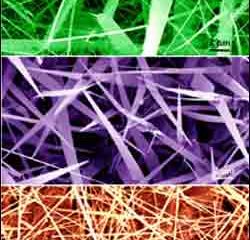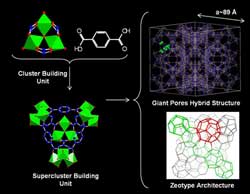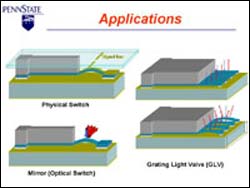Materials Sciences
Materials management deals with the research, development, manufacturing and processing of raw and industrial materials. Key aspects here are biological and medical issues, which play an increasingly important role in this field.
innovations-report offers in-depth articles related to the development and application of materials and the structure and properties of new materials.

Nanomanufacturing: Systematic study of nanostructure growth yields production ’road map’
Researchers have taken an important step toward high-volume production of new nanometer-scale structures with the first systematic study of growth conditions that affect production of one-dimensional nanostructures from the optoelectronic material cadmium selenide (CdSe).
Using the results from more than 150 different experiments in which temperature and pressure conditions were systematically varied, nanotechnology researchers at the Georgia Institute of Technology created a “roa

Silicon nitride – Improving the properties of one of the world’s most important structural materials
Tape-cast silicon nitride for high temperature applications
With excellent high temperature strength, good resistance to oxidation and low coefficient of thermal expansion Si3N4 ceramic is one of the most important structural materials. However, the pure silicon nitride ceramics are difficult to densify and the addition of various oxides is used to improve sinterability.
Previous work has shown Lu2O3-SiO2 additives are useful in improving the bending strength of Si3N4 at

Stronger than steel, harder than diamonds
FSU researcher developing numerous uses for extraordinary ’buckypaper’
Working with a material 10 times lighter than steel — but 250 times stronger — would be a dream come true for any engineer. If this material also had amazing properties that made it highly conductive of heat and electricity, it would start to sound like something out of a science fiction novel. Yet one Florida State University research group, the Florida Advanced Center for Composite Technologies

Novel processing of Yttrium Aluminum Garnet promises improved raw materials for lasers
Synthesis of Yttrium Aluminum Garnet by modifying the citrate precursor method
Yttrium Aluminum Garnet (YAG) is an important material used in the production of laser systems, for coating electronic devices, for tubes of cathodic rays and recently it has been considered as a suitable material for structural applications at high temperatures. In order to be successful in these applications the material properties such as optical properties, chemical stability at high temperature

Innovation in Nanoporous Chemistry
Science researchers from the University of Versailles (France), in collaboration with the ID31 beam line at the European Synchrotron Radiation Facility (ESRF), report their progress in the design and characterisation of microporous materials. The combination of adept chemistry and computational design made possible the synthesis of a new material, named MIL-101 by its originators, (where MIL stands for Matériaux de l’Institut Lavoisier), with very large internal pores (ø~3.4nm) and surface area

Precision bonding makes tiny high performance actuators possible
Using a new precision bonding process they developed, Penn State researchers have designed and fabricated tiny new piezoelectric microactuators — the largest only a hair’s breadth wide — based on coupling commercially available materials with existing micromachining technology.
The new actuators promise to be low cost, and capable of providing controlled force, high resolution and large displacements appropriate for applications in RF switches for cell phones, for exa